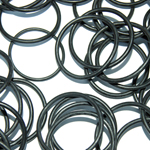What is a Nominal Size?
Understanding Nominal Seals and Gaskets
In manufacturing, a nominal size is primarily for identification rather than reflecting exact product dimensions, often corresponding to standardised measurements and tolerances within the product’s domain.
These nominal sizes can either be widely standardised across an industry or unique to a particular manufacturer. To apply nominal sizes effectively, one must understand the sizing systems in both relevant areas.
Nominal Size and O Rings
A nominal size, in the context of O Rings and engineering components, is primarily used for identification rather than precise representation of physical dimensions.
In essence, it’s a size “in name only.” Nominal sizes are important for O Rings for several reasons:
- Identification: Nominal sizes streamline O Ring selection for manufacturers, engineers, and users, simplifying the process of choosing the right one from a wide array of sizes and types.
- Standardisation: Nominal sizes often correspond to standardised dimensions and tolerances within the domain of O Rings. These standards ensure consistent physical characteristics among O Rings of the same nominal size, promoting interchangeability in diverse applications.
- Compatibility: Nominal sizes provide a common language for communication within the industry. Engineers and manufacturers can specify O Rings by their nominal size, ensuring that the selected O Ring fits properly in the intended groove or mating surface.
- Ease of Selection: When replacing or selecting O Rings, knowing the nominal size narrows down the options significantly. This simplifies the process of finding a suitable replacement or choosing the right O Ring for a new application.
- Cross-Industry and Cross-Manufacturer Use: Nominal sizes may be used consistently across multiple industries and by various manufacturers. This universality allows for greater flexibility and ease in sourcing O Rings from different suppliers or using them in different contexts.
- Tolerance Consideration: O Rings often have tolerance ranges associated with their nominal sizes. Engineers can choose O Rings with specific tolerances to ensure a precise fit and seal in their applications.
In summary, nominal sizes for O Rings form a standardised system crucial for their design and versatile use across industries and applications. They simplify the process of finding the right O Ring for the job while ensuring compatibility and reliability.
What is the Sizing System for an O Ring?
1.
When replacing a worn or damaged seal, begin by measuring the cross-section “W.” This will quickly determine if it’s an imperial (inch) size (BSI806), a metric standard (BS4518), or another metric size.
Once you’ve identified this, refer to the relevant section in our O Ring Brochure. Then, measure the inside diameter (I.D.) as accurately as possible, preferably with a vernier caliper.
Typically, ‘O’ Rings are described by I.D. x section (e.g., 10 x 2.5). With these two measurements, you can select the closest available ‘O’ Ring from stock.
If uncertain, opt for a slightly larger section, as it will likely compress to fit a slightly smaller I.D. The exact size is the ideal choice.
2.
If you’re missing the ‘O’ Ring and only have the shaft, rod, piston, or housing (referred to as ‘the metalwork’), you can use the application descriptions on page 5 of our brochure and the groove dimensions on pages 30 and 31 to determine the closest ‘O’ Ring size. Remember the points from section 1.
3.
During the design stage, aim for simplicity. Whenever possible, select sizes and materials available in stock. Specify exotic or non-standard options only if there are no other choices. Adhere to recommended surface finishes and tolerances.
Consider factors like the application, media, temperature, and pressure the ‘O’ Ring will encounter, as they influence size and material selection. Higher pressure requires minimal gap and may need anti-extrusion or backup washers, resulting in wider grooves.
If factors are uncertain, opt for the largest ‘O’ Ring that fits the nominal groove diameter; it handles metalwork variations, surface defects, and high temperatures.
Think about how the ‘O’ Ring will be fitted – 5% stretch is acceptable, but limit outside diameter compression to 3%, especially for dynamic applications. Compression is needed for function, but avoid excessive deformation; follow groove depth guidelines and note sizes marked with an asterisk (*) for dynamic applications.
Ensure good leads and chamfers, remove sharp edges, and recommend fitting tools and suitable lubricants. The exception is rare cases involving gas permeation; then, use the smallest cross-section that seals in a groove of almost equal volume. Seek advice for Explosive Decompression, which requires special materials and size selection.
To find out more about how M Barnwell Services can assist with your seal requirements, please contact our specialist team. E & OE.
